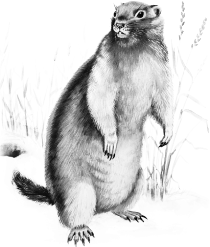
In collaboration with the scientists we have created Karakan Natural Reserve; we are continuing to fund the works of biological monitoring and restoration of the lands of Kuzbass steppes. Based on this research we are planning to choose the optimal method of reclamation of the disturbed lands
In 2011 PJSC KTK donated part of its lands, for which the mining permit had already been received, for the creation of Karakan Natural Reserve.
The creation of the natural reserve enabled to prevent the populations of rare plants and animals listed in the Red Book of Russia from extinction. These plants and animals make up steppe and meadow vegetation communities, which are unique in its combination and diversity.
The project was implemented in collaboration with scientific and public organizations:
PJSC handed over part of the lands, owned by the company and classified as industrial lands, for the creation of a specially protected natural reserve area.
The first regional natural reserve area, Karakan Natural Reserve, was created. The natural reserve is meant to preserve the plant and animal life.
Since 2014 Vinogradovsky Open-pit Mine has been conducting an experiment of the development of restoration methods for the steppe vegetation which had existed on the Karakan Ridge before mining operations.
During the last ten years the length of the Karakan Ridge has almost halved and only through the KTK environmental policy it was able to conserve the central part, which is the highest and the most interesting part of the Ridge.
In fact the Karakan Ridge is a kind of an “insurance policy” of the vegetation of the Kuznetsk Depression. By conserving the vegetation cover of the Ridge we will be able to restore the Kuznetsk Depression lands disturbed by coal mining.

The natural reserve is located in Belovo and Prokopyevsk districts of Kemerovo region adjacent to the villages of Karakan, Permyaki, Karalda, Tykhta.
The reserve area has two parts: the northern and southern parts between which coal is mined. We are carrying out restoration works for the integrity of the Ridge.
The area of the natural reserve is 1087 ha which may encompass 1300 football pitches

Greater spotted eagle is a large bird slightly smaller than a golden eagle in size. They are found in a rather narrow area from the southern forest steppe zone to the middle taiga zone of the Northern Eurasia. It is an endangered species vulnerable to extinction. Several birds of this species are found on the slopes of the Karakan Ridge.

Siberian fawn lily is a Siberian primrose or a snowdrop. In the early spring as early as the snow melts, this flower carpets the fringes of the forest with a light-violet color. The plant is listed in the Red Book of Russia as the habitat of the lily is limited by the territory of Kemerovo region.

Small, interesting beetle belonging to the Family of Stag Beetles. A distinctive feature of the beetle is a conspicuous large horn. This beetle may be usually found in deciduous forests. The stag beetle and its grubs feed on the decaying wood, decomposing dead trees and cleaning the forest floor.

A rare species of swallowtail butterflies listed in various Red Books, including the Red Book of Kemerovo region. This is one of the largest and the most beautiful butterflies of Kuzbass. It is usually found on the open steppificated slopes, rocky and high-altitude areas where its forage plants, various species of stonecrops, grow. In case of danger the Apollo falls onto the grass threateningly opening its brightly-spotted wings.

Colonies of this small animal are found in different places of the Kuznetsk Depression. This species is listed in the Red Book of Kemerovo region. Karakan Natural Reserve is the only place in the steppe zone where the marmot may feel safe.

The plant is listed in the Red Book of Russia. The area, where the feather grass used to be widespread 100 years ago, is plummeting dramatically. In Kemerovo region feather grass steppes have almost vanished.

One of the most common and numerous representatives of the feathered family. By adopting the philosophy “We cannot be defeated while we hold together”, a fieldfare prefers to stay in large flocks. They build nests and grow nestlings together, in the winter they migrate through the towns and villages together peaking round rowan and wild apple alleys. Even though it’s just a bird, the fieldfare is bright and clever. In these days farmers and gardeners have been suffering considerable damage from this bird.

It is a rare bird of prey, which is found only in the steppe areas, including the Karakan Ridge. All harriers are characterized by a noiseless, smooth, low-level flight above the ground. A harrier mainly feeds on mouse-like rodents and field mice, thereby meaningfully benefiting for the human. They bring out nestlings on the ground. The cock feeds the hatching hen and the nestlings during the first time of their lives; later on the hen starts hunting. The only way to conserve this beautiful and useful bird is to conserve the landscapes of the Kuznetsk steppe, which is the home land for the bird.

Spring iris is better known as spotted orchis. This a small iris compared to the other wild and more numerous fellow cultivated plants. They blossom in the early spring or in May emitting delicate odor. Thanks to its gentle charm long time ago as far back as the 19th century it was incorporated into the Russian culture. In spite of being widely spread in Siberia one may observe mass depletion of its number due to the anthropogenic activity. In some regions it has already been listed as a rare and endangered species.
